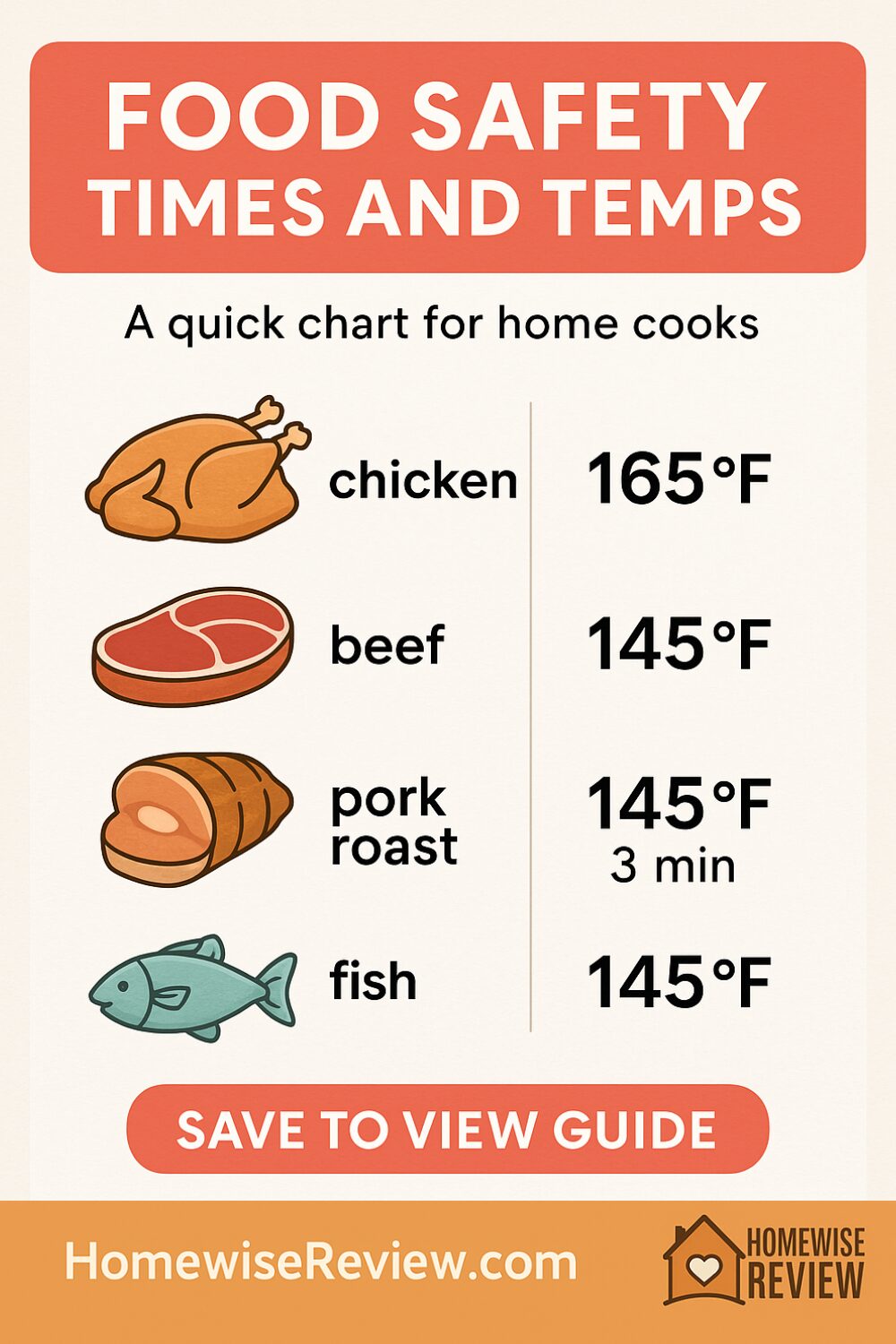
Cooking at home should feel relaxed and safe. The fastest way to stay out of the danger zone is to control two things that never lie: time and temperature. Color, juices, and guesswork are unreliable. A simple thermometer and a few guardrails will do more to protect your family than any fancy gadget.
This guide is your keep-on-the-fridge reference for everyday cooking and weekend batch sessions. It distills the essentials into one place so you do not have to hunt through long government PDFs while dinner is sputtering on the stove. You will see the safe internal temperatures for common proteins, the short rest times that finish the cook without drying food, and the quick holding rules that keep meals out of the 40 to 140°F danger zone. We also include fridge and freezer timelines for leftovers, reheating targets, and the safest ways to thaw when you forgot to pull the chicken this morning.
Think of it as a workflow, not trivia. Take the temperature at the thickest spot, avoid bone, and check in two places on large cuts. Let steaks and roasts rest the full three minutes when a rest is listed. Cool big pots in shallow containers so they pass through the danger zone quickly. When reheating, aim for 165°F all the way through and stir once in the microwave so pockets do not lag behind.
If you only remember four things, make it these: poultry 165°F, ground meats 160°F, whole cuts 145°F with a 3 minute rest, and the two hour rule for getting food into the fridge. Pair that with clean boards for raw meat, regular handwashing, and a quick wipe of fridge handles and you have already eliminated the most common home-kitchen mistakes. The chart below fills in the rest so you can cook with confidence and get back to enjoying the meal.
Safe internal temperatures
| Food | Temp | Rest |
|---|---|---|
| Poultry (whole, parts, ground, stuffing) | 165°F | none |
| Ground meats (beef, pork, lamb, venison) | 160°F | none |
| Beef, pork, veal, lamb steaks or chops | 145°F | 3 min |
| Pork roasts | 145°F | 3 min |
| Ham, raw | 145°F | 3 min |
| Ham, precooked to reheat | 140°F if USDA-packaged, 165°F otherwise | none |
| Egg dishes (quiche, frittata) | 160°F | none |
| Casseroles | 165°F | none |
| Fish (whole or fillet) | 145°F or opaque and flakes | none |
| Shrimp, crab, scallops | Cook until pearly or opaque | — |
Source: FoodSafety.gov safe minimum internal temperature chart. FoodSafety.gov
The danger zone and quick holding rules
- Danger zone: 40°F to 140°F. Keep food out of this range.
- Two hour rule: Refrigerate perishable food within 2 hours. If it is 90°F or hotter, refrigerate within 1 hour.
- Cold holding: Fridge at 40°F or below. Freezer at 0°F or below.
Source: USDA AskUSDA and FDA guidance. USDA Ask+1
Fast fridge and freezer times
(Quality guidance for home kitchens. Shorter is safer for taste and texture.)
| Item | Fridge | Freezer |
|---|---|---|
| Raw chicken or turkey (whole or parts) | 1–2 days | 9 months to 1 year |
| Raw ground meat | 1–2 days | 3–4 months |
| Raw steaks or chops | 3–5 days | 4–12 months |
| Cooked meat or poultry, leftovers | 3–4 days | 2–6 months |
| Soups and stews | 3–4 days | 2–3 months |
| Pizza | 3–4 days | 1–2 months |
Source: FoodSafety.gov cold storage charts. FoodSafety.gov
Reheating and cooling
- Leftovers: Reheat to 165°F throughout. Stir or rotate in the microwave and check several spots with a thermometer.
- Cool fast: Divide big pots into shallow containers before refrigerating.
Source: AskUSDA reheating guidance and CDC four steps to food safety. USDA Ask+1
Thawing that keeps food safe
- Best: Thaw in the refrigerator.
- Faster: Thaw in cold water, change water every 30 minutes, then cook right away.
- Microwave: Thaw, then cook immediately.
- Never: Do not thaw on the counter.
Source: FDA safe food handling. fda.gov
Quick technique tips
- Calibrate or spot-check your thermometer in ice water for confidence.
- Take temps at the thickest part, avoiding bone or the pan.
- Let whole roasts and steaks that require a rest sit the full 3 minutes so the center finishes safely.
- When in doubt, throw it out.
FAQs
Do clear juices mean meat is done?
No. Color and juices are unreliable. Use a thermometer. Poultry 165°F. Ground meats 160°F. Whole cuts like steak or pork roast 145°F plus a 3 minute rest.
Where do I place the thermometer?
Into the thickest part, avoiding bone, fat, and the pan. For poultry, check the deepest breast and inner thigh. For burgers, center of the patty. For roasts, check two spots.
What is the danger zone and how long can food sit out?
40°F to 140°F is the danger zone. Refrigerate within 2 hours. If it is 90°F or hotter, refrigerate within 1 hour. Keep hot foods at 140°F or above and cold foods at 40°F or below.
How hot for reheating leftovers and how do I cool soup safely?
Reheat to 165°F throughout. Stir or rotate in the microwave and spot check. Cool big pots fast by dividing into shallow containers before refrigerating.
What is the safest way to thaw and can I refreeze?
Best is in the fridge. Faster: cold water with a change every 30 minutes or microwave then cook right away. You can refreeze meat thawed in the fridge, though quality may drop. If thawed in cold water or microwave, cook before refreezing.
Affiliate Disclosure
If you purchase through links on our site, we may earn a small commission at no extra cost to you.




